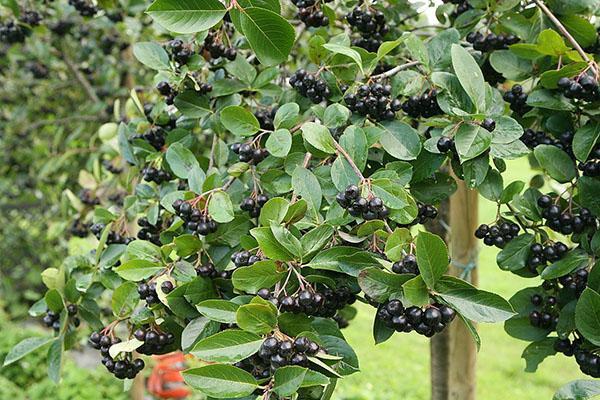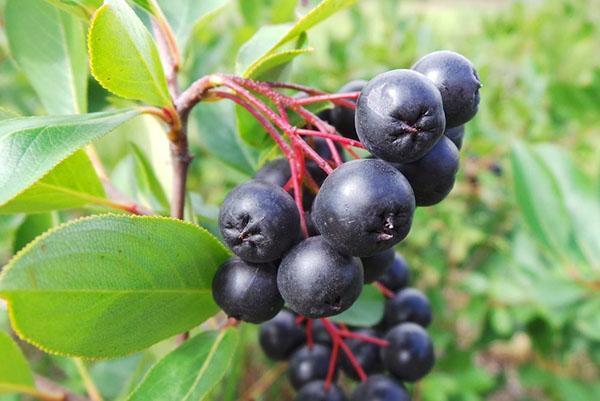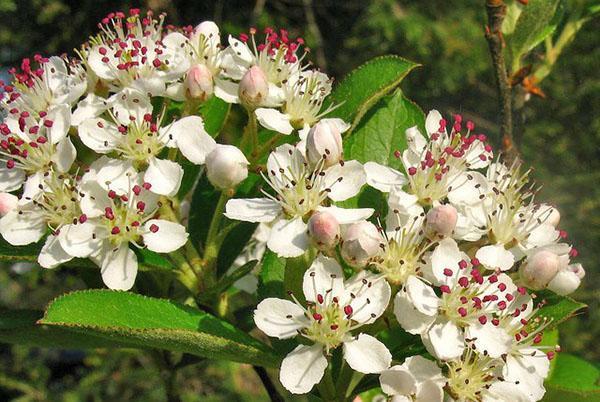Planting a fruit shrub chokeberry
 Chokeberry or black chokeberry is a well-known plant in many parts of Russia and abroad. An unpretentious shrub is used not only for harvesting healthy and tasty fruits, but also for landscaping. By the fall, green foliage in summer is colored with all shades of yellow, golden, red, in the form of single plantings or a living wall, magnificently decorating the site.
Chokeberry or black chokeberry is a well-known plant in many parts of Russia and abroad. An unpretentious shrub is used not only for harvesting healthy and tasty fruits, but also for landscaping. By the fall, green foliage in summer is colored with all shades of yellow, golden, red, in the form of single plantings or a living wall, magnificently decorating the site.
Description of chokeberry chokeberry

Thanks to the breeding work of I.V. Michurin and his associates, who received large-fruited varieties of chokeberry, she attracted the attention of domestic gardeners.
Planting and caring for chokeberry aronia require minimal knowledge and effort. Unpretentious shrub:
- tolerates winter without damage;
- begins to bear fruit within 3 years after planting, and the yields are stable and annual;
- easy to crown formation.
According to the description, black chokeberry in nature has a height of 2 to 3 meters. At first, the crown of the shrub is quite compact, but as it grows, it becomes more and more branched, spreading, wide. The diameter of an adult bush reaches two meters, so gardeners practice annual pruning and plant formation. It is easy to distinguish perennial shoots from new growth by the color of the bark.
The older the branch, the more gray its surface becomes. The bark of one- or two-year-old wood has a reddish or brownish-brown hue.
Although the culture is often called chokeberry, the plants are not closely related. This is clearly visible if you look at the chokeberry foliage. Unlike dissected rowan leaves, here leaf plates 5–8 cm long are oval or obovate, simple. They have a smooth front and pubescent dorsum and a scalloped edge. The petiole is short, dense.
When the leaves of the shrub change color from dark green to yellow and purple in autumn, the look of the plant changes. Against such a bright background, brushes of ripe fruits, purple with a bluish tint, look incredibly beautiful.
 The flowering of black chokeberry begins in the second half of May and lasts until the first days of summer, then green ovaries appear in place of white or light pink flowers collected in corymbose inflorescences. Almost black fruits ripen in early autumn and can remain on the branches without loss of quality until mid-October. Unharvested crops are readily pecked by birds.
The flowering of black chokeberry begins in the second half of May and lasts until the first days of summer, then green ovaries appear in place of white or light pink flowers collected in corymbose inflorescences. Almost black fruits ripen in early autumn and can remain on the branches without loss of quality until mid-October. Unharvested crops are readily pecked by birds.
Planting chokeberry
 As with all fruit shrubs, there are two planting dates for chokeberry. In the fall, the seedlings are transferred to the ground from mid-September to November. In spring, the shrub is most often planted in April, when the growing season begins, but the leaf buds have not yet awakened.
As with all fruit shrubs, there are two planting dates for chokeberry. In the fall, the seedlings are transferred to the ground from mid-September to November. In spring, the shrub is most often planted in April, when the growing season begins, but the leaf buds have not yet awakened.
When planting chokeberry, the climatic features of the region must be taken into account. It is important that the seedling has time to acclimatize before the onset of autumn cold weather, and in the spring it does not fall under frost that is destructive for the awakening crown.
The crop is undemanding and can grow on a variety of soil types, including nutrient-poor sandy soils.The root system is located at a depth of no more than 60 cm, so the chokeberry is not afraid of close-lying groundwater and spring flooding due to rapidly melting snow. At such a depth, the soil does not remain excessively moistened for long, and the roots do not have time to rot.
Best of all, the plant takes root on loose fertile soils that easily accept and give up moisture. In this case, the landing site should be located in the sun on the side protected from the cold wind. This will help the seedling to take root and grow quickly.
 Planting pits are prepared in advance so that the root system of the seedling will comfortably fit in it. On average, the depth and width of the future habitat of a plant is a wound of 50-60 cm. If you have to plant several bushes at once, take into account their growth and adhere to an interval of 3 meters for full development and lighting of the crown.
Planting pits are prepared in advance so that the root system of the seedling will comfortably fit in it. On average, the depth and width of the future habitat of a plant is a wound of 50-60 cm. If you have to plant several bushes at once, take into account their growth and adhere to an interval of 3 meters for full development and lighting of the crown.
The soil removed from the pit is mixed:
- with 8-10 kg of selected humus;
- two glasses of sifted wood ash;
- 150 grams of superphosphate.
A third of the planting hole is filled with soil, well spilled with settled water and waiting for the moisture to completely go deep. Now it is time to plant chokeberry. The seedling is immersed in a hole so that the root collar is a couple of centimeters above the ground level, covered with a prepared substrate, compacted and watered again so that the shrub settles well on the ground. The trunk circle, in order to avoid the rapid drying of the earth and the formation of a crust, is mulched abundantly.
In order for black chokeberry to take root faster, experienced gardeners advise, before planting chokeberry, to shorten the shoots on the seedling, leaving no more than 5-6 viable buds.
Chokeberry care after planting
 It is very easy to care for frost and drought-resistant shrubs. Aronia needs regular pruning of the crown, triple feeding, removal of weeds, preventive treatment against pests and infrequent but abundant watering.
It is very easy to care for frost and drought-resistant shrubs. Aronia needs regular pruning of the crown, triple feeding, removal of weeds, preventive treatment against pests and infrequent but abundant watering.
Plant pruning is carried out:
- in the fall, after harvesting the fruits and the end of the growing season;
- in early spring, before the start of the shrub awakening.
In addition to carefully cutting dry, damaged and weak branches, shoots are removed that interfere with the penetration of light and pollinator insects into the crown. Chokeberry painlessly tolerates formative pruning, therefore it can be grown as a miniature tree. To do this, at the soil level, remove all shoots, except for the strongest, and then gradually form a trunk from it. For this, over the course of several years, only a few apical buds are left on the chokeberry stem, when the plant reaches the desired height, the growth point is removed and they begin to create a compact crown at the top of the stem.
Spring begins with the treatment of shrubs from pests and feeding with a predominance  nitrogen fertilizers... Re-fertilization should be carried out after flowering, when the ovary begins to fill, one more top dressing should prepare the plant for winter. It is carried out at the end of summer without using nitrogen.
nitrogen fertilizers... Re-fertilization should be carried out after flowering, when the ovary begins to fill, one more top dressing should prepare the plant for winter. It is carried out at the end of summer without using nitrogen.
Although chokeberry can survive for a long time in drought conditions, it needs water to get an excellent yield and beauty. Watering is important:
- at the beginning of the growing season;
- in summer, during the filling and ripening of fruits;
- in the fall before the shrub leaves for the winter.
 Each bush should receive at least 20–40 liters of water once. For the greatest efficiency of the superficial root system, watering is carried out at a distance of 30–40 cm from the center of the bush, in shallow furrows.
Each bush should receive at least 20–40 liters of water once. For the greatest efficiency of the superficial root system, watering is carried out at a distance of 30–40 cm from the center of the bush, in shallow furrows.
The trunks are kept clean, for which the soil is regularly loosened or sprinkled with mulch.
Pruning chokeberry and its propagation by cuttings
 Chokeberry pruning begins from the first year of life. The beginnings form a crown of 10–12 silty branches, then, as they age, they are gradually replaced with new shoots.Rejuvenation begins at the age of 8.
Chokeberry pruning begins from the first year of life. The beginnings form a crown of 10–12 silty branches, then, as they age, they are gradually replaced with new shoots.Rejuvenation begins at the age of 8.
If the bush is neglected and loses its strength, there is no need to rush to uproot it. It is enough to cut off the entire crown at the root in the fall to wait for a strong young growth in the spring. From it in the fall they form the backbone of a new shrub.
Strong, healthy branches that need to be shortened or cut can be used for excellent planting material and for propagation of chokeberry by cuttings.
For green cuttings, take non-lignified tops or middle parts with 5–6 live buds. All the leaves, the roof of the upper pair, are cut off, and the remaining ones are shortened. Rooting is carried out in a greenhouse, in a light sandy substrate, having previously treated the cuttings with a growth stimulator. A year later, a full-fledged chokeberry seedling is formed from a small piece of a branch for planting in the ground.
Lignified cuttings are pieces of mature, one-year-old shoots with several healthy buds. They are cut in the fall and rooted in the school so that when planting, only two buds remain above the soil surface.
If there is an adult chokeberry bush on the site, it can be propagated:
- separating and planting root shoots with their own root system;
- specially rooting annual shoots, bending and securing them to the ground.
 Young plants quickly take root, only in the first years of life do they need shelter for the winter and after a couple of years they are ready to please the gardener with ripe bluish-purple or almost black hearths.
Young plants quickly take root, only in the first years of life do they need shelter for the winter and after a couple of years they are ready to please the gardener with ripe bluish-purple or almost black hearths.